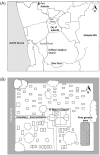Health effects of European colonization: An investigation of skeletal remains from 19th to early 20th century migrant settlers in South Australia
- PMID: 35385495
- PMCID: PMC8985932
- DOI: 10.1371/journal.pone.0265878
Health effects of European colonization: An investigation of skeletal remains from 19th to early 20th century migrant settlers in South Australia
Abstract
The British colony of South Australia, established in 1836, offered a fresh start to migrants hoping for a better life. A cohort of settlers buried in a section of St Mary's Anglican Church Cemetery (1847-1927) allocated for government funded burials was investigated to determine their health, with a focus on skeletal manifestations associated with metabolic deficiencies. Findings of St Mary's sample were compared with those published for contemporary skeletal samples from two British cemeteries, St Martin's, Birmingham, and St Peter's, Wolverhampton, to explore similarities and differences. To investigate the changing economic background of the St Mary's cohort, which may have influenced the location of their burial within the cemetery, the number and demographic profile of government funded burials and those in privately funded leased plots were compared. The study sample consisted of the skeletal remains of 65 individuals (20 adults, 45 subadults) from St Mary's Cemetery 'free ground' section. The bones and teeth of individuals in this cohort showed evidence of pathological manifestations, including areas of abnormal porosity in bone cortices in 9 adults and 12 subadults and flaring of metaphyses (one subadult) and costochondral junctions of the ribs (one subadult). Porous lesions of orbital roof bones (Types 3 to 4) were seen on three subadults. Macroscopic examination of teeth identified enamel hypoplastic defects and micro-CT scans showed areas of interglobular dentine. Comparison of St Mary's findings with the British samples revealed that prevalences of manifestations associated with vitamin C deficiency were higher at St Mary's and manifestations associated with vitamin D deficiency were lower respectively. The location of burial pattern at St Mary's Cemetery, from the mid-1840s to1860s, showed differences in the economic status of migrants. This pattern changed from the 1870s, which reflected improvements in the local economy and the economic recovery of the colony.
Conflict of interest statement
The authors have declared that no competing issues exist.
Figures








Similar articles
-
The Oral Health of a Group of 19th Century South Australian Settlers in Relation to Their General Health and Compared with That of Contemporaneous Samples.Dent J (Basel). 2023 Apr 7;11(4):99. doi: 10.3390/dj11040099. Dent J (Basel). 2023. PMID: 37185476 Free PMC article.
-
Was it worth migrating to the new British industrial colony of South Australia? Evidence from skeletal pathologies and historic records of a sample of 19th-century settlers.Int J Paleopathol. 2022 Jun;37:41-52. doi: 10.1016/j.ijpp.2022.04.002. Epub 2022 Apr 27. Int J Paleopathol. 2022. PMID: 35489278
-
The palaeopathology of scurvy in Europe.Int J Paleopathol. 2014 Jun;5:55-62. doi: 10.1016/j.ijpp.2013.09.001. Epub 2013 Nov 8. Int J Paleopathol. 2014. PMID: 29539468
-
Skeletal manifestations of infantile scurvy.Am J Phys Anthropol. 2006 Feb;129(2):163-72. doi: 10.1002/ajpa.20265. Am J Phys Anthropol. 2006. PMID: 16323179
-
Deficit of skeletal remains belonging to infants and young children - but not at every cemetery!Anthropol Anz. 2023 Sep 28;80(4):385-395. doi: 10.1127/anthranz/2023/1657. Anthropol Anz. 2023. PMID: 37020417
Cited by
-
Complex traces: Examining morbidity and mortality among 19th Century migrants to South Australia using a Complex Adaptive Systems framework.PLoS One. 2025 Jul 17;20(7):e0320268. doi: 10.1371/journal.pone.0320268. eCollection 2025. PLoS One. 2025. PMID: 40674433 Free PMC article.
-
The Oral Health of a Group of 19th Century South Australian Settlers in Relation to Their General Health and Compared with That of Contemporaneous Samples.Dent J (Basel). 2023 Apr 7;11(4):99. doi: 10.3390/dj11040099. Dent J (Basel). 2023. PMID: 37185476 Free PMC article.
References
-
- Betsinger TK, DeWitte SN. The Bioarchaeology of Urbanization: Biological The, Demographic, and Social Consequences of Living in Cities. 1st ed. Switerland: Springer International Publishing; 2020.
-
- Szreter S. Economic Growth, Disruption, Deprivation, Disease, and Death: On the Importance of the Politics of Public Health for Development. Population and Development Review. 1997; 23(4):693–728. doi: 10.2307/2137377 - DOI
-
- Szreter S. Urbanization, Mortality, and the Standard of Living Debate: New Estimates of the Expectation of Life at Birth in Nineteenth-Century British Cities. In: Health and Wealth. Boydell & Brewer; 2005. p. 165.
-
- Ashworth WJ. The industrial revolution the State, knowledge and global trade. London: Bloomsbury Academic; 2017.
MeSH terms
LinkOut - more resources
Full Text Sources

